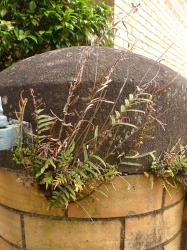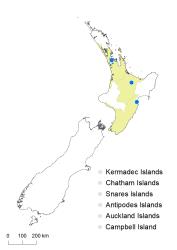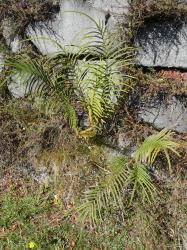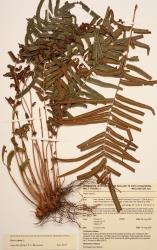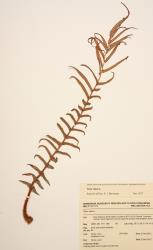Rhizomes short-creeping, up to 40 mm long (in herbarium specimens), scaly. Rhizome scales very narrowly ovate, 2–5 mm long, 0.1–0.5 mm wide, pale brown, concolorous, entire. Fronds 95–1220 mm long. Stipes 10–180 mm long, pale brown, densely scaly; scales similar to those of rhizome but decreasing in size distally. Rachises pale brown, not winged, sparsely scaly; rachis scales very narrowly ovate, pale brown. Laminae 1-pinnate, 85–1180 mm long, 30–270 mm wide, obovate, mid-green on both surfaces, coriaceous; hair-like scales on abaxial costa surfaces. Primary pinnae in 8–40 pairs and a long terminal pinna, not overlapping; the longest above the middle, 16–220 mm long, 2.5–10 mm wide, very narrowly ovate, auricled at base, straight; basal pinnae much reduced; pinna apices acuminate, margins irregularly serrate when young and inrolled at maturity, bases short-stalked. Veins free. Sori continuous along sides of primary pinnae.
Note: Fronds on AK 223495 collected from Epsom, Auckland, were said to reach 1600 mm long.
Pteris vittata is the only species of the genus in New Zealand with 1-pinnate laminae and undivided primary pinnae. Other species have basal primary pinnae that are themselves pinnatifid (P. cretica and P. multifida) or are much more divided. It is further distinguished by its obovate laminae, free veins and dense covering of pale brown scales on the rhizomes and stipes.
North Island: Auckland, Volcanic Plateau, Southern North Island.
Altitudinal range: 0–340 m.
Pteris vittata has been recorded from Auckland city, the banks of Lake Rotomohana, and Napier.
Occurs naturally in tropical and warm temperate areas of southern Europe, Africa, Madagascar, Asia, Australia (Western Australia, Northern Territory, Queensland, New South Wales, Victoria), Solomon Islands, Vanuatu, New Caledonia, Fiji, and Tonga. It is naturalised in Hawai‘i (Palmer 2003), and in the tropics and subtropics of North and South America (Mickel & Smith 2004).
In urban areas in New Zealand Pteris vittata has been recorded from brick and scoria walls, but at Lake Rotomahana it was recorded growing in a thermally active area in soil with a pH of 6.1.
The biostatus of Pteris vittata in New Zealand has been discussed by Brownsey & Perrie (2012) and Ecroyd & Miller (2012). The latter authors consider it to be self-established at the Lake Rotomahana site, possibly from eastern Australia, in contrast to the view taken here that it is fully naturalised.
Cameron & Parris (1998). Voucher AK 223419–223421, 1995.



